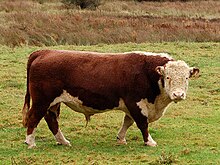 Bull near Ufton, in Warwickshire | |
| Conservation status | DAD-IS (2023): not at risk[1] |
|---|---|
| Country of origin | United Kingdom |
| Distribution | more than 60 countries[2] |
| Use | beef |
| Traits | |
| Weight | |
| Height | |
| Coat | red and white |
| Horn status | horned or polled |
| |
The Hereford is a British breed of beef cattle originally from Herefordshire in the West Midlands of England.[3] It was the result of selective breeding from the mid-eighteenth century by a few families in Herefordshire, beginning some decades before the noted work of Robert Bakewell.[4]: 197
It has spread to many countries; in 2023 the populations reported by 62 countries totalled over seven million head; populations of over 100000 were reported by Uruguay, Brazil and Chile.[2] The breed reached Ireland in 1775, and a few went to Kentucky in the United States in 1817; the modern American Hereford derives from a herd established in 1840 in Albany, New York.[4]: 197 [5] It was present in Australia before 1850, and in Argentina from 1858. In the twenty-first century there are breed societies in those countries and in the Czech Republic, Denmark, Estonia, France, Hungary, the Netherlands, Norway, Portugal, Spain and Sweden in Europe; in Brazil, Chile, Paraguay and Uruguay in South America; in New Zealand; and in South Africa.[4]: 198
- ^ a b c d e Cite error: The named reference
dadwas invoked but never defined (see the help page). - ^ a b Cite error: The named reference
dad2was invoked but never defined (see the help page). - ^ Sanders, Alvin H. (1914). The story of the Herefords. Chicago: Sanders Publishing Company. Retrieved 12 July 2009.
- ^ a b c Cite error: The named reference
cabiwas invoked but never defined (see the help page). - ^ "Early Chronology of the Hereford Breed 1723-1955". The Hereford Herd Book Society. 1995. Retrieved 5 April 2010.